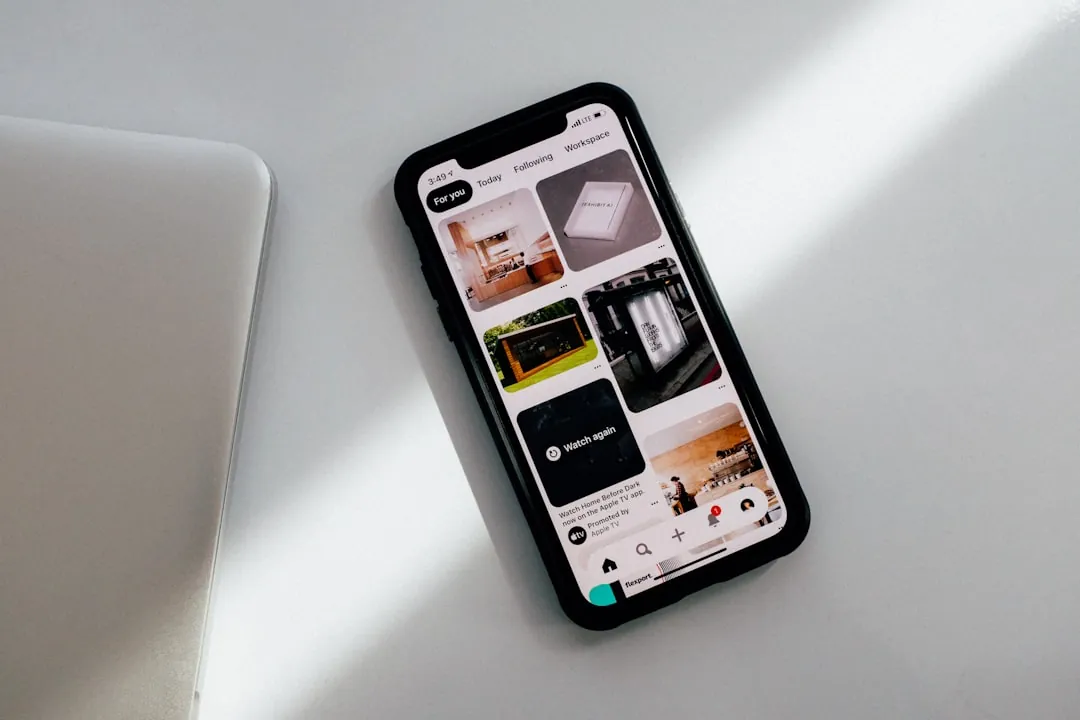Hey everyone, welcome back to Earn With Web! I'm so excited to dive into a topic that's near and dear to my heart (and my wallet): Pinterest for business. For years, I underestimated the power of this visual search engine, thinking it was just for DIY crafts and recipe inspiration. Boy, was I wrong!
I remember vividly when I finally decided to give Pinterest a serious try. I had just launched my online store selling handmade jewelry, and my marketing efforts were… well, let's just say they weren't stellar. Facebook ads were costing a fortune, and Instagram was a constant battle for visibility. A friend suggested Pinterest, and I initially scoffed. "Pinterest? Really? Jewelry?"
But then I did some research. I saw other small businesses thriving on the platform, driving massive traffic to their websites, and generating consistent sales. I figured, what did I have to lose?
Fast forward a few months, and Pinterest had become my number one source of traffic and sales. I was kicking myself for not starting sooner! Now, I’m here to share everything I’ve learned so you can avoid the same mistakes I made and start leveraging the power of Pinterest to grow your online business and earn with web.
Let's get started!
Why Pinterest is a Goldmine for Online Businesses
Pinterest is more than just a social media platform; it's a visual search engine. People use it to discover ideas, plan projects, and, most importantly, shop. Think of it like Google, but with pictures. And that’s where the magic happens for online businesses.
- Massive Reach: Pinterest boasts hundreds of millions of active monthly users. That's a huge audience potentially interested in your products or services.
- High Purchase Intent: Unlike passive scrolling on other platforms, Pinterest users are actively searching for things to buy, make, or do. They're in a "discovery" mindset, making them more receptive to your offers.
- Evergreen Content: Pins have a longer lifespan than posts on Facebook or Instagram. A well-optimized pin can continue to drive traffic and sales for months, even years, after it's published. Think of it as a passive income generator!
- Referral Traffic Powerhouse: Pinterest is known for driving referral traffic. Users clicking on your Pins are often directed straight to your website or product page. More traffic = more potential customers.
According to Pinterest Business, 97% of Pinterest users say they get inspiration on the platform and 87% have purchased something because of Pinterest. These are stats you can't ignore!

Setting Up Your Pinterest Business Account
Okay, you're convinced that Pinterest is worth your time. Now, let's get your business account set up correctly. This is a crucial first step, so pay attention!
Step 1: Convert to a Business Account (or Create One)
If you already have a personal Pinterest account, you can easily convert it to a business account. Just go to your settings and look for the "Convert to business account" option. If you don't have an account yet, sign up for a new business account directly.
Why a Business Account is Essential:
- Analytics: Access to detailed analytics to track your performance, understand your audience, and optimize your strategy.
- Pinterest Ads: The ability to run targeted ad campaigns to reach a wider audience.
- Rich Pins: Enhanced pin formats that provide more information and improve user experience (more on this later).
Step 2: Optimize Your Profile
Think of your Pinterest profile as your storefront. It needs to be visually appealing and clearly communicate what your business is about.
- Profile Picture: Use your logo or a high-quality headshot. Make sure it's recognizable and consistent with your branding.
- Business Name: Use your full business name or a shortened version that's easy to remember.
- Bio: Write a concise and compelling bio that explains what you offer and what makes you unique. Include relevant keywords to help people find you in search.
- Example: "Handmade jewelry for the modern woman. Shop our collection of unique earrings, necklaces, and bracelets. Free shipping on orders over $50!"
- Website: Verify your website to claim your brand on Pinterest. This adds credibility and allows you to track traffic from your pins.
Step 3: Claim Your Website (Super Important!)
Claiming your website is crucial for unlocking advanced features and analytics. Here's how:
- Go to your Pinterest settings.
- Click on "Claim."
- Follow the instructions to add a meta tag to your website's header or upload an HTML file to your server.
Once your website is claimed, you'll see a checkmark next to your website address on your profile, confirming that you own the domain.
Understanding Keywords and SEO
Just like Google, Pinterest relies on keywords to understand what your pins are about and show them to the right people. Keyword research is essential for maximizing your reach.
How to Find Relevant Keywords:
- Pinterest Search Bar: Start typing a keyword related to your business in the Pinterest search bar. Pinterest will suggest related keywords that people are actually searching for.
- Pinterest Trends: Use Pinterest Trends to see what's popular in your niche. This can help you identify trending topics and create timely content.
- Google Keyword Planner: Use Google Keyword Planner to find high-volume, low-competition keywords related to your business.
- Competitor Analysis: See what keywords your competitors are using in their pin descriptions and board titles.
Where to Use Keywords:
- Profile Bio: As mentioned earlier, include relevant keywords in your profile bio to help people find you.
- Board Titles: Create board titles that are descriptive and keyword-rich.
- Example: Instead of "My Jewelry," use "Handmade Silver Earrings" or "Bohemian Necklace Designs."
- Board Descriptions: Write detailed descriptions for each board, using relevant keywords to explain what the board is about.
- Pin Descriptions: Craft compelling pin descriptions that include relevant keywords and a clear call to action.
- Example: "Shop our stunning collection of handmade silver earrings! Perfect for adding a touch of elegance to any outfit. Click here to browse now! #silverearrings #handmadejewelry #jewelrydesign"
Creating Amazing Pins That Get Noticed
Pinterest is a visual platform, so your pins need to be eye-catching and engaging. Here's how to create pins that stand out from the crowd:
- High-Quality Images: Use high-resolution images that are clear, well-lit, and visually appealing. Avoid blurry or pixelated images.
- Vertical Format: Pinterest favors vertical pins. Aim for an aspect ratio of 2:3 (e.g., 1000 x 1500 pixels).
- Text Overlays: Add text overlays to your pins to make them more informative and engaging. Use clear, concise text that highlights the key benefits or features of your product or service.
- Branding: Use consistent branding across all your pins to build brand recognition. This includes using your logo, brand colors, and fonts.
- Call to Action: Include a clear call to action in your pin description and/or text overlay. Tell people what you want them to do (e.g., "Shop Now," "Learn More," "Read the Blog Post").
Tools for Creating Stunning Pins:
- Canva: An easy-to-use graphic design tool with pre-designed Pinterest templates. I use Canva daily!
- Adobe Photoshop: A more advanced graphic design tool for creating custom pins.
- Tailwind Create: A Pinterest-specific design tool that helps you create multiple pin variations quickly.
Example:
Let's say you sell organic skincare products. Instead of just pinning a picture of your product, you could create a pin that shows a before-and-after photo, a list of key ingredients, and a call to action like "Get Glowing Skin Naturally!"
Mastering Pinterest Strategies for Maximum Impact
Creating great pins is only half the battle. You also need to implement effective Pinterest strategies to maximize your reach and drive traffic to your website.
- Consistency is Key: Pin regularly to keep your audience engaged and show Pinterest that you're an active user. Aim to pin at least 5-10 pins per day.
- Pin at the Right Times: Use Pinterest Analytics to identify the best times to pin based on when your audience is most active.
- Join Group Boards: Group boards are collaborative boards where multiple users can contribute pins. Joining relevant group boards can expose your pins to a wider audience. Find group boards in your niche by searching on Pingroupie.
- Schedule Your Pins: Use a Pinterest scheduler like Tailwind or Buffer to schedule your pins in advance. This saves time and ensures that you're pinning consistently.
- Analyze Your Results: Track your pin performance using Pinterest Analytics to see what's working and what's not. Adjust your strategy based on your findings.

Leveraging Rich Pins
Rich Pins are a special type of pin that automatically syncs information from your website to your pins. There are four types of Rich Pins:
- Article Pins: Display the headline, author, and story description from your blog post.
- Product Pins: Display the price, availability, and where to buy the product.
- Recipe Pins: Display the ingredients, cooking time, and serving size.
- App Pins: Allow users to download your app directly from Pinterest.
Benefits of Rich Pins:
- More Information: Provide users with more information about your products or services.
- Increased Engagement: Attract more clicks and saves.
- Improved SEO: Help Pinterest understand what your pins are about.
To enable Rich Pins, you need to add metadata to your website's pages. Pinterest provides detailed instructions on how to do this. If you are using WordPress, you can use a plugin like Yoast SEO to easily add the required metadata.
Pinterest Ads: Turbocharge Your Reach
Organic Pinterest marketing can be incredibly effective, but if you want to accelerate your growth, consider using Pinterest Ads. Pinterest Ads allow you to target specific audiences based on their interests, demographics, and behavior.
Types of Pinterest Ads:
- Promoted Pins: Regular pins that you pay to promote to a wider audience.
- Promoted Video Pins: Video pins that you pay to promote.
- Promoted App Pins: App pins that you pay to promote.
- Collection Ads: A visually appealing ad format that showcases multiple products in a single pin.
Tips for Creating Effective Pinterest Ads:
- Set Clear Goals: Define what you want to achieve with your ads (e.g., increase website traffic, generate leads, drive sales).
- Target the Right Audience: Use Pinterest's targeting options to reach the people who are most likely to be interested in your products or services.
- Create Compelling Ad Copy: Write clear, concise, and persuasive ad copy that highlights the key benefits of your offer.
- Use High-Quality Images and Videos: Your ads need to be visually appealing to grab attention.
- Track Your Results: Monitor your ad performance and make adjustments as needed.
I recommend starting with a small budget and testing different ad variations to see what works best. Don't be afraid to experiment!
Internal Linking for SEO Boost
Remember, we want to keep people on our site (Earn With Web) as long as possible. Internal linking is key to that and helps with SEO too! Here are a few suggestions on where you can add links to other relevant content on our site:
- When discussing SEO, link to an article about "Keyword Research Strategies for 2024."
- When mentioning online stores, link to a guide on "Starting Your Own E-commerce Business."
- When discussing income generation, link to an article about "Affiliate Marketing for Beginners."
This not only helps with SEO but also provides valuable context for the reader and keeps them engaged with our content.

Common Mistakes to Avoid
- Ignoring Analytics: Not tracking your performance and adjusting your strategy accordingly.
- Inconsistent Pinning: Not pinning regularly.
- Low-Quality Images: Using blurry or pixelated images.
- Spammy Pin Descriptions: Writing keyword-stuffed pin descriptions that don't provide value.
- Not Engaging with Your Audience: Not responding to comments or questions.
- Not Optimizing for Mobile: Forgetting that most Pinterest users are on mobile devices.
Conclusion
Pinterest is a powerful platform for online businesses, but it takes time and effort to see results. Don't get discouraged if you don't see immediate success. Keep experimenting, keep learning, and keep pinning!
By following the tips and strategies outlined in this guide, you can unlock the power of Pinterest and start driving massive traffic and sales to your website.
Ready to start earning with web on Pinterest? Go set up your business account today!
Frequently Asked Questions
Q: How long does it take to see results on Pinterest?
A: It can take several months to see significant results on Pinterest. The key is to be patient, consistent, and keep optimizing your strategy.
Q: How much time should I spend on Pinterest each day?
A: Aim to spend at least 30-60 minutes per day on Pinterest. This includes creating pins, scheduling pins, engaging with your audience, and analyzing your results.
Q: Do I need to use a Pinterest scheduler?
A: While not essential, a Pinterest scheduler can save you a lot of time and help you stay consistent.
Q: Is Pinterest still relevant in 2024?
A: Absolutely! Pinterest remains a highly valuable platform for businesses, with continued growth and a strong focus on visual discovery.
Q: What if my niche isn't visually appealing?
A: Every niche can find success on Pinterest. You just need to be creative with your visuals. Use high-quality stock photos, create infographics, or use text overlays to make your pins more engaging.
Hopefully, this guide has given you a clear understanding of how to use Pinterest for business and start earning with web. Don't hesitate to ask if you have any questions! Good luck, and happy pinning!